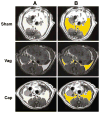Relative contributions of afferent vagal fibers to resistance to diet-induced obesity
- PMID: 22138962
- PMCID: PMC4111149
- DOI: 10.1007/s10620-011-1968-4
Relative contributions of afferent vagal fibers to resistance to diet-induced obesity
Abstract
Background: We previously demonstrated vagal neural pathways, specifically subdiaphragmatic afferent fibers, regulate expression of the intestinal sodium-glucose cotransporter SGLT1, the intestinal transporter responsible for absorption of dietary glucose. We hypothesized targeting this pathway could be a novel therapy for obesity. We therefore tested the impact of disrupting vagal signaling by total vagotomy or selective vagal de-afferentation on weight gain and fat content in diet-induced obese rats.
Methods: Male Sprague-Dawley rats (n = 5-8) underwent truncal vagotomy, selective vagal de-afferentation with capsaicin, or sham procedure. Animals were maintained for 11 months on a high-caloric Western diet. Abdominal visceral fat content was assessed by magnetic resonance imaging together with weight of fat pads at harvest. Glucose homeostasis was assessed by fasting blood glucose and HbA1C. Jejunal SGLT1 gene expression was assessed by qPCR and immunoblotting and function by glucose uptake in everted jejunal sleeves.
Results: At 11-months, vagotomized rats weighed 19% less (P = 0.003) and de-afferented rats 7% less (P = 0.19) than shams. Vagotomized and de-afferented animals had 52% (P < 0.0001) and 18% reduction (P = 0.039) in visceral abdominal fat, respectively. There were no changes in blood glucose or glycemic indexes. SGLT1 mRNA, protein and function were unchanged across all cohorts at 11-months postoperatively.
Conclusions: Truncal vagotomy led to significant reductions in both diet-induced weight gain and visceral abdominal fat deposition. Vagal de-afferentation led to a more modest, but clinically and statistically significant, reduction in visceral abdominal fat. As increased visceral abdominal fat is associated with excess morbidity and mortality, vagal de-afferentation may be a useful adjunct in bariatric surgery.
Conflict of interest statement
Figures





Comment in
-
Treating diet-induced obesity: a new role for vagal afferents?Dig Dis Sci. 2012 May;57(5):1115-7. doi: 10.1007/s10620-012-2122-7. Epub 2012 Mar 22. Dig Dis Sci. 2012. PMID: 22438205 No abstract available.
Similar articles
-
Capsaicin-sensitive vagal afferents modulate posttranscriptional regulation of the rat Na+/glucose cotransporter SGLT1.Am J Physiol Gastrointest Liver Physiol. 2008 Apr;294(4):G1078-83. doi: 10.1152/ajpgi.00591.2007. Epub 2008 Feb 28. Am J Physiol Gastrointest Liver Physiol. 2008. PMID: 18308853
-
Capsaicin as an anti-obesity drug.Prog Drug Res. 2014;68:171-9. doi: 10.1007/978-3-0348-0828-6_7. Prog Drug Res. 2014. PMID: 24941669 Review.
-
Experimental colitis decreases rat jejunal amino acid absorption: role of capsaicin sensitive primary afferents.Life Sci. 2001 Nov 9;69(25-26):3121-31. doi: 10.1016/s0024-3205(01)01418-7. Life Sci. 2001. PMID: 11758837
-
Treating diet-induced obesity: a new role for vagal afferents?Dig Dis Sci. 2012 May;57(5):1115-7. doi: 10.1007/s10620-012-2122-7. Epub 2012 Mar 22. Dig Dis Sci. 2012. PMID: 22438205 No abstract available.
-
Capsaicin-sensitive intestinal mucosal afferent mechanism and body fat distribution.Life Sci. 2008 Jul 4;83(1-2):1-5. doi: 10.1016/j.lfs.2008.04.018. Epub 2008 May 11. Life Sci. 2008. PMID: 18541272 Review.
Cited by
-
The Role of the Vagal Nucleus Tractus Solitarius in the Therapeutic Effects of Obesity Surgery and Other Interventional Therapies on Type 2 Diabetes.Obes Surg. 2016 Dec;26(12):3045-3057. doi: 10.1007/s11695-016-2419-2. Obes Surg. 2016. PMID: 27730463 Review.
-
Effect of Portal Glucose Sensing on Systemic Glucose Levels in SD and ZDF Rats.PLoS One. 2016 Nov 2;11(11):e0165592. doi: 10.1371/journal.pone.0165592. eCollection 2016. PLoS One. 2016. PMID: 27806092 Free PMC article.
-
Vagal afferent controls of feeding: a possible role for gastrointestinal BDNF.Clin Auton Res. 2013 Feb;23(1):15-31. doi: 10.1007/s10286-012-0170-x. Epub 2012 Jun 21. Clin Auton Res. 2013. PMID: 22717678 Review.
-
Reduction of intestinal electrogenic glucose absorption after duodenojejunal bypass in a mouse model.Obes Surg. 2013 Sep;23(9):1361-9. doi: 10.1007/s11695-013-0954-7. Obes Surg. 2013. PMID: 23585076
-
Foregut exclusion disrupts intestinal glucose sensing and alters portal nutrient and hormonal milieu.Diabetes. 2015 Jun;64(6):1941-50. doi: 10.2337/db14-1578. Epub 2015 Jan 9. Diabetes. 2015. PMID: 25576062 Free PMC article.
References
-
- Boss TJ, Peters J, Patti MG, Lustig RH, Kral JG. Laparoscopic truncal vagotomy for severe obesity: six month experience in 10 patients from a prospective, two-center study. Surg Obes Relat Dis. 2007;3:292.
-
- Kral JG. Vagotomy for treatment of severe obesity. Lancet. 1978;1:307–308. - PubMed
-
- Kral JG. Effects of truncal vagotomy on body weight and hyperinsulinemia in morbid obesity. Am J Clin Nutr. 1980;33:416–419. - PubMed
Publication types
MeSH terms
Substances
Grants and funding
LinkOut - more resources
Full Text Sources
Other Literature Sources
Medical
Research Materials

